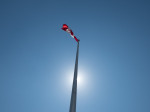Fuji X30 discontinued but still working
In 2016 I had an opportunity to take a fantastic trip to Paris and London and really wanted a small point and shoot camera that was up to the task. My previous camera that would have fit this bill was the Nikon P7000 but it’s getting old for a digital camera and resets itself every time the battery is removed. As well sensor technology has also improved in the interim primarily in low light. I wont go through all the choices I considered but the Fujifilm X30 was only ever an outside consideration as I was looking at the newly released Panasonic Z100 and the Sony RX100 IV both of which cost more than $1000. By chance however the local camera store (actually a pharmacy and the last camera outlet standing) was having a small camera show with representatives from different manufacturers and dealers. Among these was Fujifilm with some wonderful new cameras and lenses as well as the X30 which was approaching 2 years old and being discontinued. In addition it had the same lens and sensor and processor as the previous model the X20 making the camera seem a little dated. But then there was the price when all was said and done it cost only about 1/3 of the Sony. So aside from the price what other feature would prompt me to forgo buying the best camera I could afford? Well there is the form factor, it’s a nice camera to hold and with all the external dials its easy to use without the need to hunt through menus.  And the 2.360K-dot OLED viewfinder. I’ve never liked EVFs but when I looked through this one I had to admit that it was very good and is a pleasure to use.
And the 2.360K-dot OLED viewfinder. I’ve never liked EVFs but when I looked through this one I had to admit that it was very good and is a pleasure to use.  It is large and clear and provides useful information and most importantly for me it did not suffer from lag in low light. In fact Fujifilm claims that the refresh rate is 0.005 of a second. I find that if I pan and the image doesn’t refresh fast enough it causes mild nausea which is not conducive to enjoying photography, one of the main reasons I prefer optical viewfinders. But the X30 viewfinder excels I’m not going to list off the features and specifications of the X30 those are easily found online but rather try to explain where the camera excels and where it does not.
It is large and clear and provides useful information and most importantly for me it did not suffer from lag in low light. In fact Fujifilm claims that the refresh rate is 0.005 of a second. I find that if I pan and the image doesn’t refresh fast enough it causes mild nausea which is not conducive to enjoying photography, one of the main reasons I prefer optical viewfinders. But the X30 viewfinder excels I’m not going to list off the features and specifications of the X30 those are easily found online but rather try to explain where the camera excels and where it does not.
The first thing to be addressed is its ISO range and in particular noise at higher settings. I ran a few tests and as expected it was not a particularly good performer at higher ISO settings. Here is a crop from one test comparing ISO 100 to ISO 800.
So during this testing I determined that ISO 1600 was the upper limit that I was comfortable using to achieve results that I could live with but that limiting it to under ISO 800 was preferable. This is not state of the art territory but it’s also not like you can not take pictures at those values especially given the X30 lenses F2.0-f2.8 maximum aperture.
For reference this is what a 100% crop at 3200 ISO looks like without noise reduction. Not useable for me.
The focal range of the lens 7.1-28.4mm yields an angle of view for its sensor that is equivalent to 28-112mm in 35mm terms. While I like 28mm and use it often it would have been nice to have a somewhat wider lens such as 24mm.
Over the next little while I used the X30 when ever I could in order to see how well it performed. What I found was that it was a well laid out camera with good autofocus that produced nice images, what more can you expect. Well larger files such as 20mpixel rather than 12mpixel would be nice and better low light performance would be good. However if you stay within the boundaries of where the X30 works well it is a good all around point and shoot. The X30 also excels at close focus photography as well allowing images taken as close as 1cm to the lens in ‘Super Macro’ mode.  One other minor issue was the movie record button, I find myself hitting it inadvertently far too often ending up with useless short video clips and sometimes a missed photograph. It wasn’t the only digital camera I took and I tended to only use it when traveling as light as possible such as inside museums, a place where it isn’t the strongest.
One other minor issue was the movie record button, I find myself hitting it inadvertently far too often ending up with useless short video clips and sometimes a missed photograph. It wasn’t the only digital camera I took and I tended to only use it when traveling as light as possible such as inside museums, a place where it isn’t the strongest.
Fuji has discontinued the X30 as I mentioned and the have not signaled that there will be a replacement. Nikon has also decided to stop development of their DL series of compacts before they ever made it to market. The point and shoot camera market is practically dead and even the high end compact market which the X30 sat in is limited with Sony and Panasonic dominating that segment with a few exceptions.
What follows are some images from prior to my trip as I tested the Fuji X30 in an other post I will share some of the images from the trip.











































































